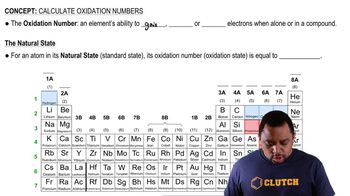Here are the essential concepts you must grasp in order to answer the question correctly.
Oxidation Numbers
Oxidation numbers are a way to keep track of electron transfer in chemical reactions. They represent the hypothetical charge an atom would have if all bonds were ionic. The rules for assigning oxidation numbers include that the oxidation number of an element in its elemental form is zero, and for monoatomic ions, it equals the charge of the ion.
Recommended video:
Rules for Assigning Oxidation Numbers
There are specific rules for assigning oxidation numbers, such as oxygen typically having an oxidation number of -2, and hydrogen usually being +1. In compounds, the sum of oxidation numbers must equal the overall charge of the molecule or ion. For polyatomic ions, this rule helps in determining the oxidation states of individual elements.
Recommended video:
Sulfite Ion (SO3)
The sulfite ion (SO3) consists of one sulfur atom and three oxygen atoms. To assign oxidation numbers in SO3, we start by assigning -2 to each oxygen, leading to a total of -6 from the three oxygens. The sulfur must then have an oxidation number of +4 to balance the overall charge of the ion, which is neutral.
Recommended video:
 Verified step by step guidance
Verified step by step guidance


